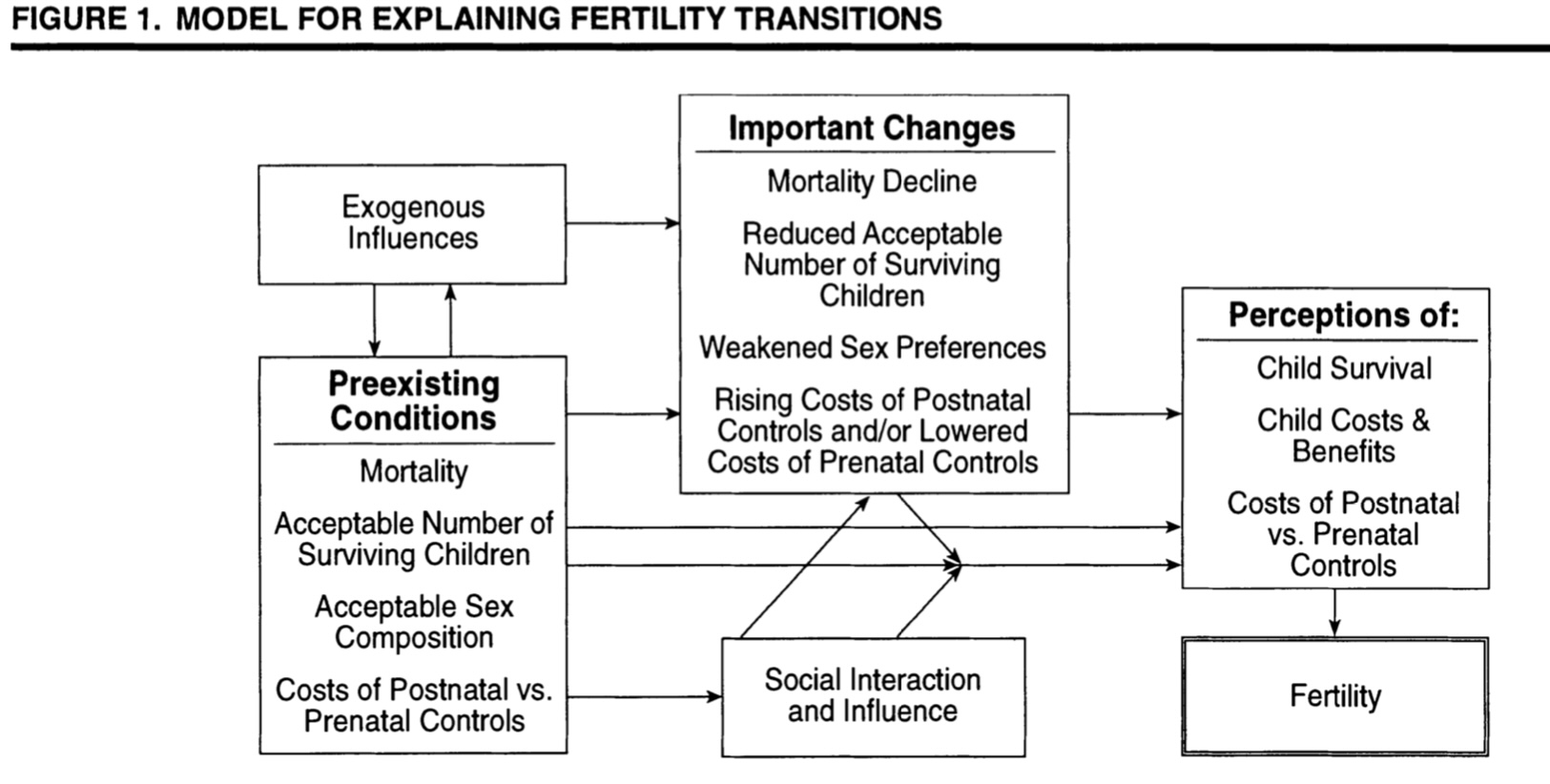
Mason 1997
Major Theories
Demographic transition theory: fertility decline is caused by industrialization + urbanization
Plausible on a millenium scale
Incomplete theory
Classic transition theory with an addition: modernization + shift in values toward individualism and self-fulfillment
Doesn’t fit with developing countries
Wealth flows: fertility decline is caused by the emotional nucleation of the family, triggered by economic + cultural forces
Children = net economic beneficiaries of family life
Applicable to Sub-Saharan Africa
Doesn’t work in East Asia and Western Europe
Neoclassical microeconomic theory of fertility: 3 proximate determinants of couples fertility choices
Cost of children vs. other goods
Income
Preferences for children vs. other forms of consumption
Doesn’t account for environmental + institutional conditions
Easterlin’s framework: neoclassical microeconomic theory of fertility + sociological variable → supply of children
Supply for children
Demand for children
Costs of fertility regulation
Doesn’t account for institutional conditions
Ideational theory: timing of fertility transition depends on the diffusion of information + new social norms about birth control
Doesn’t apply to Africa
Incomplete
Four Errors in Our Thinking
1. Assuming that all transitions have the same cause
Existence of potentially important influences on fertility in only some times or places
Diffusion of information and ideas about fertility limitation can influence reproductive behavior in the absence of major structural changes
There is enormous demographic + social variation across pre-transitional populations
2. Ignoring mortality decline as a precondition of fertility behaviour decline
Without a mortality decline, a fertility decline is highly unlikely
Recent theories tend to ignore this pre-condition because of particular findings
3. Assuming that the regulation of fertility is fundamentally different in pre-transitional and post-transitional populations
Natural fertility: fertility that is socially controlled but not controlled by individuals on a parity-specific basis
Recognizing the historical continuity of family planning
Stop stereotyping all pre-transitional populations as mindless puppets of culture
4. Focusing on a decadal time scale
Decadal time scale = misleading results
Princeton European Fertility Project: assumed that the effects of economic modernization on fertility would be felt immediately regardless of other conditions
We need to test our theories on a lengthier or looser scale than the decade
Toward a Better Theory
Important facts
Fertility transitions occur when conditions are combined
1st country to undergo a fertility transition experienced changes that encourage fertility limitation and other countries are influenced by this 1st country
The speed of influences travelling through regions varies on many factors
Mortality decline is a necessary condition but not a sufficient condition
The number of surviving children varies across pre-transitional populations
Parents use offspring control when the number of children exceeds the family’s capacity to accommodate them
The forms of control available to parents
New models must be ideational and interactive
Model for explaining fertility transitions:

Mason 1997
Major Theories
Demographic transition theory: fertility decline is caused by industrialization + urbanization
Plausible on a millenium scale
Incomplete theory
Classic transition theory with an addition: modernization + shift in values toward individualism and self-fulfillment
Doesn’t fit with developing countries
Wealth flows: fertility decline is caused by the emotional nucleation of the family, triggered by economic + cultural forces
Children = net economic beneficiaries of family life
Applicable to Sub-Saharan Africa
Doesn’t work in East Asia and Western Europe
Neoclassical microeconomic theory of fertility: 3 proximate determinants of couples fertility choices
Cost of children vs. other goods
Income
Preferences for children vs. other forms of consumption
Doesn’t account for environmental + institutional conditions
Easterlin’s framework: neoclassical microeconomic theory of fertility + sociological variable → supply of children
Supply for children
Demand for children
Costs of fertility regulation
Doesn’t account for institutional conditions
Ideational theory: timing of fertility transition depends on the diffusion of information + new social norms about birth control
Doesn’t apply to Africa
Incomplete
Four Errors in Our Thinking
1. Assuming that all transitions have the same cause
Existence of potentially important influences on fertility in only some times or places
Diffusion of information and ideas about fertility limitation can influence reproductive behavior in the absence of major structural changes
There is enormous demographic + social variation across pre-transitional populations
2. Ignoring mortality decline as a precondition of fertility behaviour decline
Without a mortality decline, a fertility decline is highly unlikely
Recent theories tend to ignore this pre-condition because of particular findings
3. Assuming that the regulation of fertility is fundamentally different in pre-transitional and post-transitional populations
Natural fertility: fertility that is socially controlled but not controlled by individuals on a parity-specific basis
Recognizing the historical continuity of family planning
Stop stereotyping all pre-transitional populations as mindless puppets of culture
4. Focusing on a decadal time scale
Decadal time scale = misleading results
Princeton European Fertility Project: assumed that the effects of economic modernization on fertility would be felt immediately regardless of other conditions
We need to test our theories on a lengthier or looser scale than the decade
Toward a Better Theory
Important facts
Fertility transitions occur when conditions are combined
1st country to undergo a fertility transition experienced changes that encourage fertility limitation and other countries are influenced by this 1st country
The speed of influences travelling through regions varies on many factors
Mortality decline is a necessary condition but not a sufficient condition
The number of surviving children varies across pre-transitional populations
Parents use offspring control when the number of children exceeds the family’s capacity to accommodate them
The forms of control available to parents
New models must be ideational and interactive
Model for explaining fertility transitions:

 Knowt
Knowt